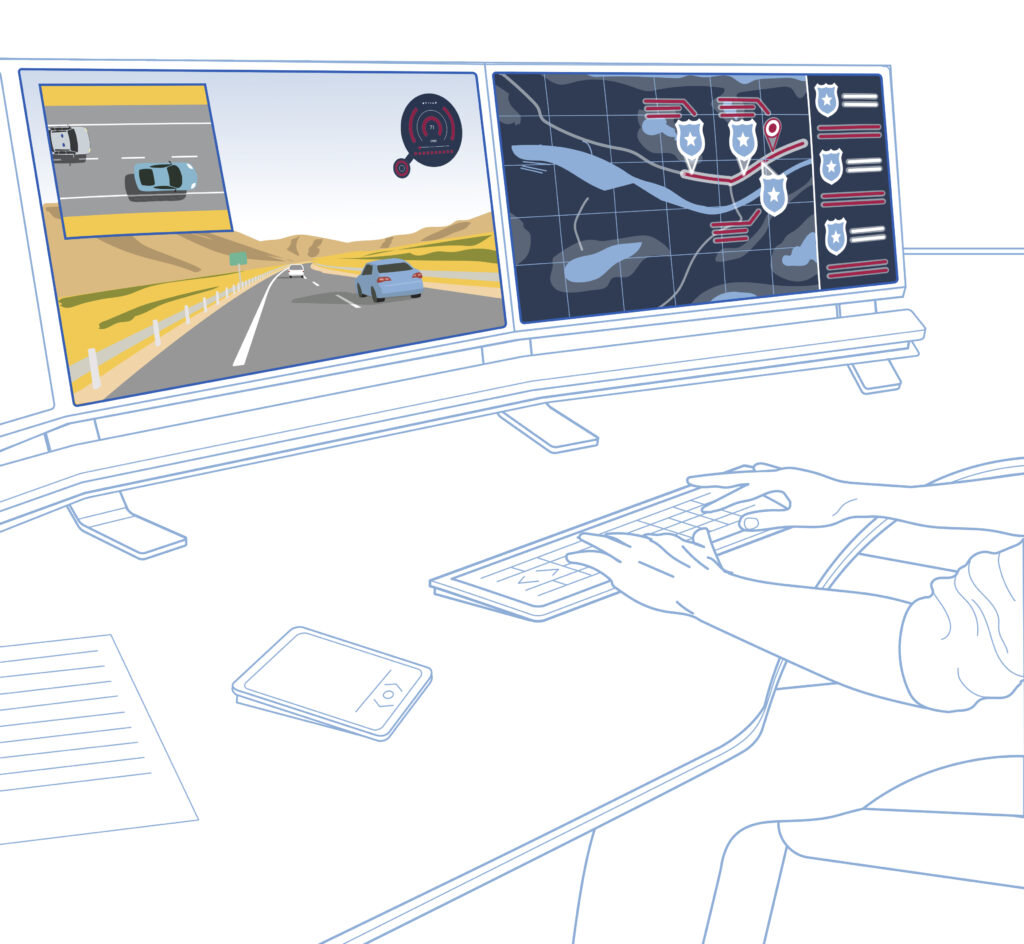By:
VNC Automotive
Date:
21st April 2021
- VNC Automotive predicts explosion of technology integration for police and first responder vehicles
- New systems will allow more effective policing and emergency management
- Augmented reality, drone and robotic device integration will form integrated command centres in vehicles for first responders.
Police and first responder vehicles are set to undergo a technology revolution, that will include augmented reality, mobile surveillance and remote device control according to transport and connectivity software pioneer VNC Automotive.
“We can empower police and first responders to work more effectively.”
Drawing on the immerging trends in consumer vehicles, and taking the latest applications borne from mobile phone platforms, the UK based software expert is already in discussion with forces and conversion specialists as it integrates new systems into a car’s existing infrastructure.
“We’re already seeing a focus on app-based solutions, but there is now a shift towards exploring how technology including remote control functionality, the relaying of remote surveillance footage to a car’s dashboard and even augmented reality,” explains Philip Handschin, Technical Consultant at VNC Automotive. “However, all this functionality needs to remain intuitive and easily integrated with the large format touch screens that are becoming commonplace in today’s vehicles.”
With over a decade’s experience in passenger vehicle systems, and its work in approximately 35 million vehicles worldwide, VNC Automotive is well versed in programming highly effective entertainment, navigation and comfort control systems. However, this knowledge is now proving invaluable when it comes to law enforcement and first responder vehicle conversions.
“We can tap into the systems that OEMs build into cars, utilising large format touch screens and the existing hardware for communication and connectivity, but add functionality that empowers police and first responders to allow them to work more effectively and make better-informed decisions,” says Handschin.

Philip Handschin – Technical Consultant, VNC Automotive
Information highways
Every second counts in an emergency, and responders need to have access to the latest information – whether they’re running standard checks, on route or in pursuit.
The status of team vehicles, including air support, and other emergency services, is vital, as is getting on scene quickly – taking into account traffic and other delays. All this means that information presented to the driver and passenger in a form that is quickly assimilated is vital. “The benefits that augmented reality can provide are obvious when considering navigation, call status and database information. It also means the driver need not take their eye off the road, and can make decisions with fewer distractions.”
This includes technologies like ANPR (Automatic Number Plate Recognition), where the instantaneous notification of illegal and stolen vehicles and banned drivers allows action to be taken quickly and effectively, removing issues from roads.
With the emergence of drones and advanced robotics (such as the headline grabbing Boston Dynamics’ Spot) it isn’t too much of a stretch to see how video and data from units operating in dangerous environments can be relayed to vehicles and allow police, paramedics and even fire fighters the chance to react accordingly.

Visualisation – field view from mission control
Smart responders
Already many police and responder services are moving to mobile devices, with smartphones replacing separate items of equipment. In some cases smart platforms and apps now form part of the daily work process, including reporting and file management, database access and team communications.
With a host of connectivity services built into the cars at the factory as standard, allowing an officer’s phone to sync with a vehicle is an obvious first step, but VNC Automotive can go beyond what standard consumer systems offer. More than just being able to make a call, its IVI connectivity software includes options like the automatic locking of the car when away from the vehicle (talking with a member of the public or pursuing a suspect on foot), the ability to activate remote functions like sirens, cameras and PA systems, or even transmit location information in an emergency.
Looking ahead this line of thinking allows for the future integration of wearable tech, that can cover biometrics, personal security and incident management.
Reducing cabin pressure
With long shifts and the requirement to wear bulky equipment, anything that can make officers and first responders’ time in vehicles safer, more productive and comfortable is welcome.
That extends to the ease of using the systems and technology – if the controls are awkward and movement restricted mistakes will be made and time lost. VNC Automotive’s proprietary software allows additional hardware, like rugged laptops, to be safely stowed in the boot yet seamlessly integrated via the factory fitted touch screen.
There’s a knock on benefit when it comes to passenger safety. The severity of injury during a collision rises steeply if there’s bulky equipment mounted near the dashboard. With clutter removed, airbags and other safety systems can operate as originally intended.

Visualisation – response vehicle interior of the near future
Remote controls
With so much technology in each vehicle, their function moves beyond transport and they effectively become intelligence gathering hubs – passing valuable, first-hand data back to a central command centre and allowing the coordination of teams and other services.
VNC Automotive’s solutions already allow command centres to connect with vehicles in real-time, controlling certain systems such as sirens and providing crucial navigation information to officers. Extending this idea, video and other data can be transmitted and the live feed from every vehicle used to provide a valuable net of surveillance around a serious incident. Recorded and indexed this could prove vital as evidence for later convictions.
Made to measure
VNC Automotive’s experience in the conversion of conventional cars into vehicles for the emergency services means they understand that requirements are evolving. “We’ve worked on factory equipped vehicles like the Dodge Charger Pursuit vehicle in the US, as well as with conversion companies in the UK and North America, and are in discussion with separate police forces across these regions. The US market is catered for by the OEMs, with vehicles supplied straight from the production line, but the economics are not the same in the UK. We’re the bridge in the middle, working directly with installers as well as operators to understand their needs and making it cost effective,” concludes Handschin.
VNC Automotive
21st April 2021